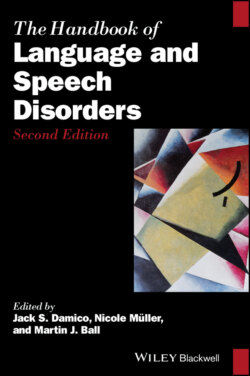Читать книгу The Handbook of Language and Speech Disorders - Группа авторов - Страница 27
2.1 Introduction
ОглавлениеFive percent of any population has difficulties with language (Hyter & Salas‐Provance, 2019). About 1 billion people (15% of the human population) show a type of disability, some of whom (2–4%) also experience difficulties with functioning (World Health Organization [WHO], 2019a). There is a new international migrant to the United States every 34 seconds (US Census). What an international migrant brings into any country is a generous amount of diversity that builds on already existing societal diversity. Diversity encompasses the variety of experiences, skills, knowledge, and attributes that shape every one of us (American Speech and Hearing Association [ASHA], 2019a) and it “can refer to gender, race, ethnicity, socio‐economic status and so on” (Goldstein & Horton‐Ikard, 2010, p. 38). Diversity also denotes difference; difference is what makes each of us unique. These terms further implicate cultural and linguistic variables that ought to be seen both at a micro‐ (individual) and at a macro‐level (society). Understanding and coping with cultural and linguistic diversity relies on both innate skills and developed core capabilities like sensitivity, awareness, knowledge, and competence. This is especially germane when such practice involves culturally and linguistically diverse (CLD) populations in need of speech and language rehabilitation, where difference may interfere with accurate diagnosis and treatment of disorder.
Multicultural and multilingual issues (MMI) (diversity) have an age‐long standing in the history of humanity, but it is a neonate field in terms of research, study, and clinical service tradition; it is even more pristine where its instruction is concerned. As the significance and relevance of the topic rightfully gains increasing recognition, the Office of Multicultural Affairs of the American Speech and Hearing Association (ASHA) advocates specific guidelines with a theoretical and a practical component to be infused in both principle and practice when diversity is at play. A vital part of MMI infusion begins (and ends!) in the professional education of service providers, like speech‐language pathologists (SLPs), an education that ought to include both existing knowledge and contemporary advances in ongoing research. There is a multitude of resources that may be used to this end.
The present chapter highlights diversity considerations in the clinical practice of speech and language disorders (SLDs), aiming to reaffirm the necessity of making such considerations stand out in the minds of clinical service providers not as an elective facet of their agenda, but as an imperative concern. It appears that although diversity considerations are continually building momentum in academic circles, the impact of such considerations is only superficially affecting SLP expertise and practice around the world. Enhancing the cultural responsiveness of clinical service providers, who are at the far end of the gamut between research and practice, is vital for two reasons. First, research assumes practical relevance for clinicians, and the perpetually scrawny link between the two is somewhat strengthened. Second, clinical practice becomes more targeted and relevant for the CLD populations in the globalized and diversified society we all share. The aim here, thus, is to reach out to service providers, both those currently incubating in educational systems worldwide but also those already in professional service contexts via the means of, for example, continuing education. As lifelong learning is reinstated as critical, associations have the potential also to be one of the main providers of adult professional education.
The way to go about this, which is also represented in the main thematic divide of this chapter, is by a two‐way process involving the consolidation and reflection of knowledge. These two related standpoints engage facts and findings (theory/research/policies) as well as each individual SLP’s insights into how well one can prepare oneself to bring appropriate assessment and intervention skills into the clinic—skills that meet the needs of CLD groups and that may need to go far beyond just the inclusion of the known and tested procedures. This second aspect is indispensable because there will always be gaps in what an SLP knows, especially given the non‐existent methods of diffusion (i.e., ways to bring empirically tested treatments [ETTs] into clinical service delivery) (American Speech and Hearing Association [ASHA], 2010), the unanswered questions in research, and the gaps in knowledge in general, while the demands of “underserved and unserved” clients “struggling to be heard and seen” (Cheng, 2014) are on the increase. Also, the distance between the two ends on the research and practice continuum will start diminishing further if/when the SLP is willing to assume new‐fangled roles like those of the ethnographer, the linguist, the person that seeks and finds answers, in other words, the researcher.
This chapter is organized in two broad thematic sections dealing with theoretical and practical aspects relating to MMI instruction in SLDs. The subsections are as follows: Some facts; What is there and what is missing; Identifying an MMI curriculum; Relevant theory; Relevant applications; Issues in cultural competence; Concluding statements.
